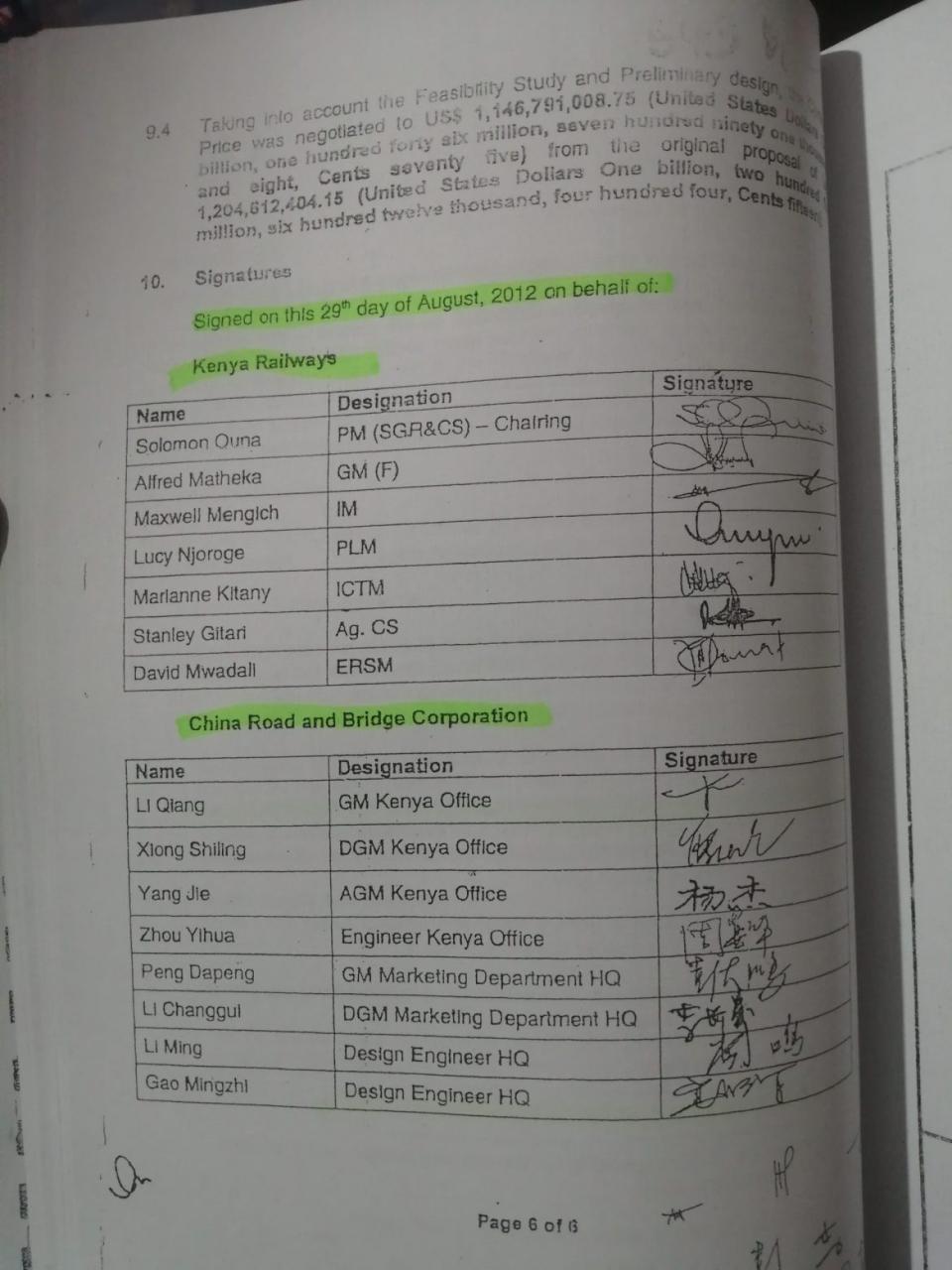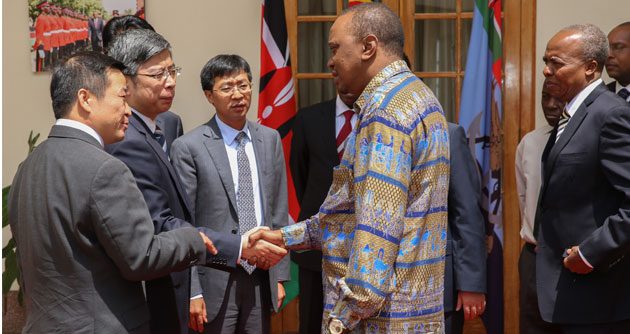


President Uhuru Kenyatta is introduced to Sun Liqiang and Li Qiang Vice Presidents of China Road and Bridge Corporation’s Kenya Office, by the CRBC Chairman Mr. Wen Gang at State House, Nairobi/PSCU.
The Standard Gauge Railway’s (SGR) contract was brought into sharp focus in February 2020 after the level of plunder and wastage that many experts had been talking about came to the fore when the Nation Media Group (NMG) got hold of the contract.
Kenyans had been warned for the longest by economist David Ndii and others that the over Sh500 Billion Railways was an unnecessary project and a sham, however, many had not seen the contract that the Government of Kenya (GoK) and Chinese Govt signed.
Well, NMG in their reporting revealed some damning things that cannot go unmentioned in this article, first, it was revealed that the grass, a natural commodity by all standards, cost over Ksh1 billion to put. Mind you, the grass dons some part of the 472km long railway, not the full length.
Secondly, it was revealed that the budget for the airtime for the lead engineer for the project was Ksh5 million. By all standards, no one can exhaust such a budget even if they call non-stop throughout the day for the period (3 years) the project was ongoing.
Thirdly, it was revealed that the Chinese workers were treated to perdiems, parties and lifestyle standards like kings. According to the contract, over Sh235 million was used for their entertainment. His house was furnished at a cost of Sh3 million and office computers bought at Sh280,000 each, while his laserjet printers cost a staggering Sh513,700 each. In total, the taxpayer forked out Sh57 million to provide office furniture.
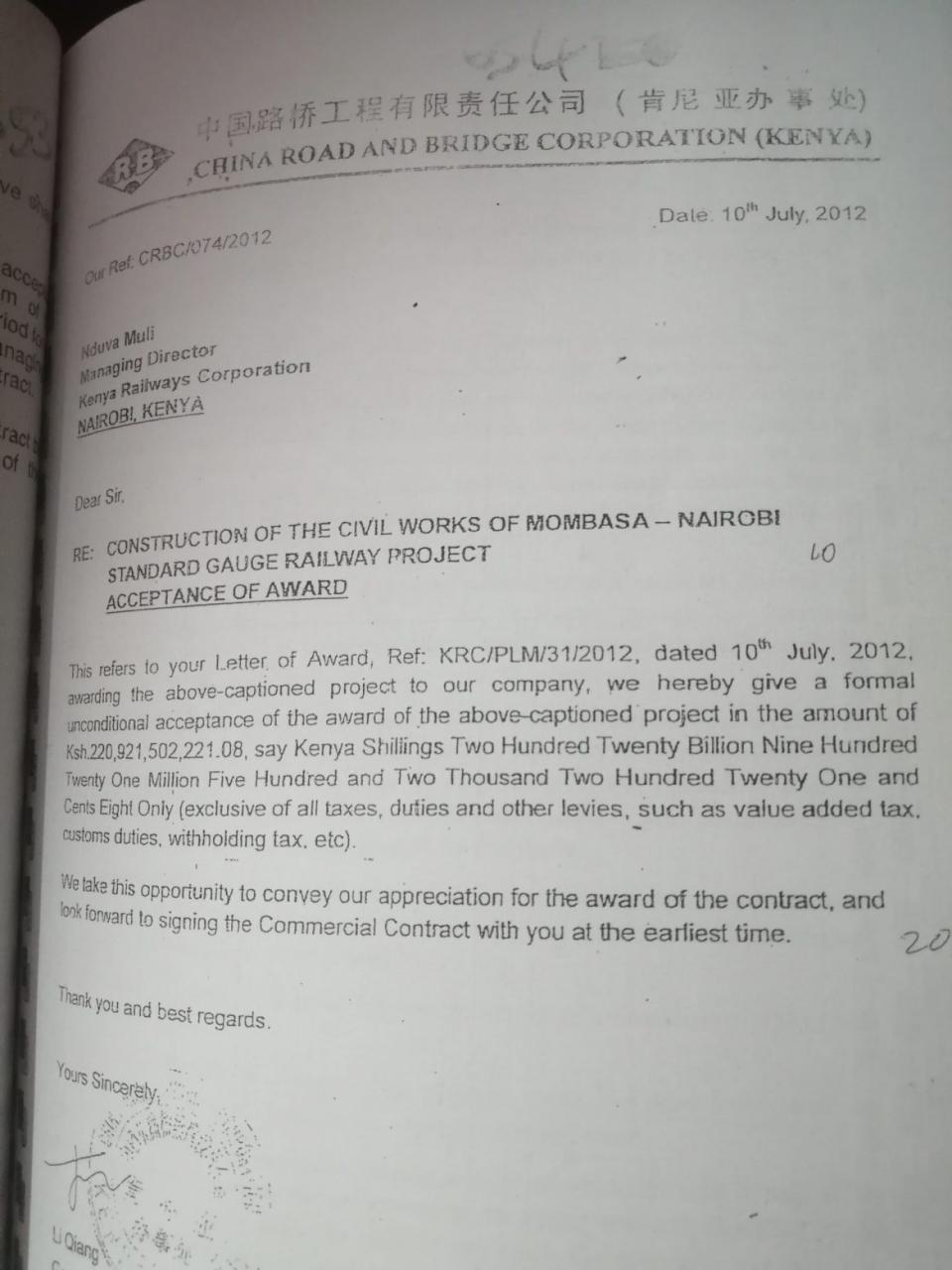
Well, let’s delve into more wastage, plunder and deceit that happened, but before that, to set the record straight, (part) title of the contract was Supply and Installation of The Facilities, Locomotives, and Rolling Stocks for the Mombasa – Nairobi Standard Gauge Railway Project, signed by the representative of the Chinese govt in Kenya, a Mr Li Qiang was the General Manager of China Road and Bridges Corporation (CRBC) and then Managing Director of Kenya Railways Nduva Muli.
The claims of inflated costs of the SGR project was recently supported (not that he didn’t also reveal it in the past) by the African Union High Representative for Infrastructure Hon. Raila Odinga in a local TV station. During the interview, Raila said that he and former President Mwai Kibaki in the coalition government had tendered the SGR project at a lower cost, but when President Uhuru Kenyatta and his deputy William Ruto took over in April 2013, they cancelled the contract and re-tendered a fresh at inflated costs.
“Before we left government with Mwai Kibaki, we awarded SGR tender to a company at USD2.5billion. But when jubilee came in in 2013, they canceled the tender and awarded it back to the same company but at USD4.5billion. Obvious inflation of figures”-Raila Odinga, said in an interview in January 2020.
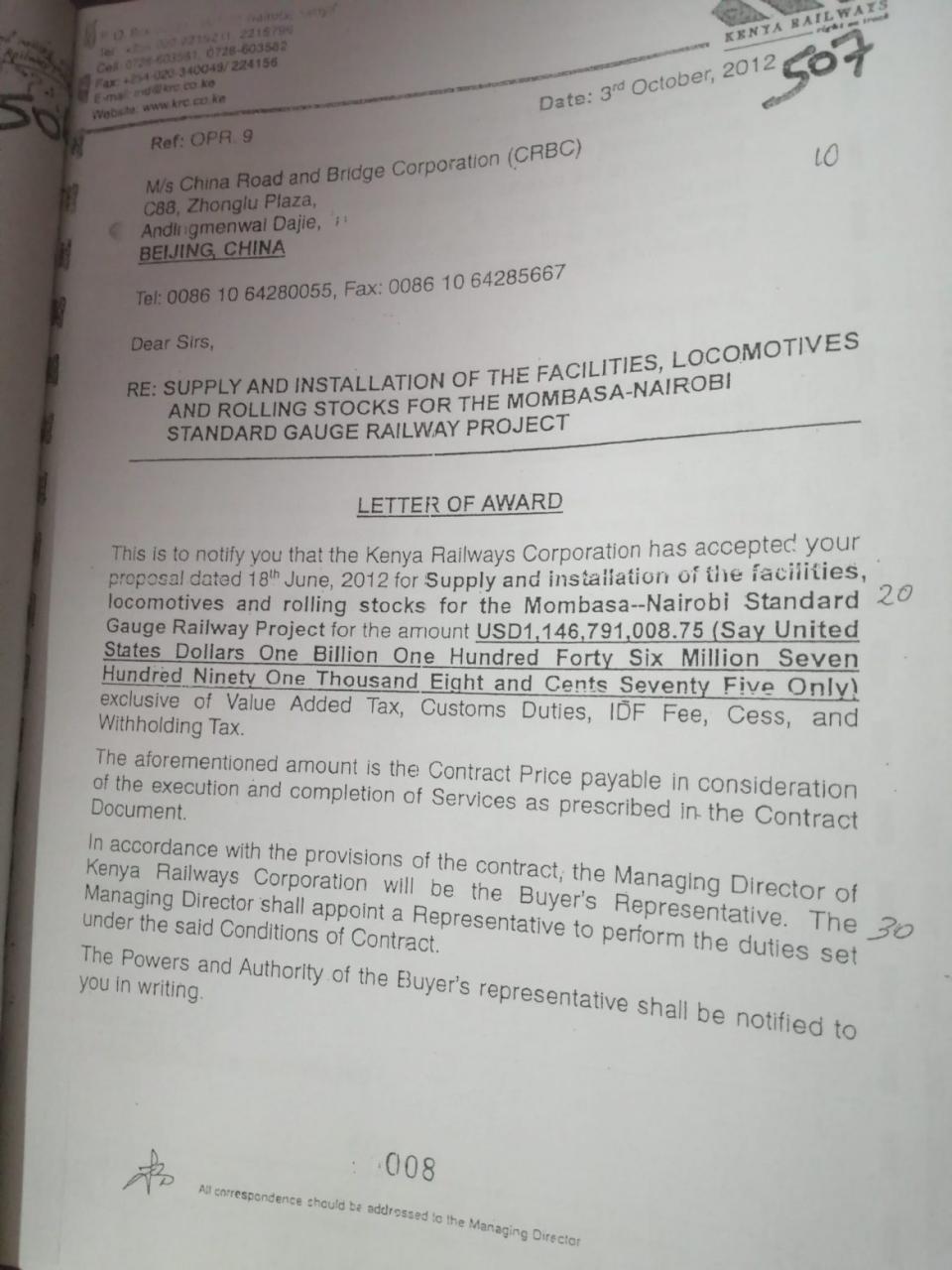
Rip off
The Managing Director for Africa Economics David Ndii has warned in the past before the project began stating that it was not viable.
“The railway has been sold as a commercially viable project, that is, it would pay for itself…I maintained that the railway could not pay, and that the debt would be paid from the public purse. This has now come to pass”. David Ndii repeated this statement that he made in 2014 in 2018 in a hard-hitting article titled, “SGR by the numbers: Some Unpleasant Arithmetic”
In February, 2014, he had lamented that the ‘debate on the proposed standard gauge railway is focusing on dodgy procurement”.
However, going by the reports that the Chinese government will take possession of some Key Kenyan installations such as the Port of Mombasa of the govt is unable to pay the debt, most Kenyans have been keen to know what the SGR contract entailed. It is also imperative that most of the poor masses would be attracted by talks about the procurement and pricing of the tender.
Now apart from what had already been reported by the mainstream media, this is what we also found.
Perusing through the contract, it is not a mean fit, the document is big but one cannot escape the charade of Section 13 Appendix A: Non-Binding Bill of Quantities area. This is 44 pages of pure thuggery.
The looters of our country led by UhuRuto saw it fit to raise the prices of basic commodities to levels unprecedented for example a mere bench cost Ksh180,000. The prices were quoted in United Stated Dollars (USD) and Kenyabulletin.com’s conversion rate for this article will be USD 1 for Ksh100.
A battery forklift that costs about Ksh900,000 was bought at Ksh1.37 million.
Acetylene cylinder normally worth Ksh5,000 was purchased at Ksh38,040.
A good lighting arrester retailing for between Ksh500 and Ksh3000 was sold to Kenya at the price of Ksh11,680.
It is important to note that the prices given already have a mark-up and that the price quoted by the looters of Kenya, the difference is what they took home.
The level of theft that was carried out in this project makes the government and all those that benefited in the inflated costs term real news as fake.
uhondo.news is aware that the Chairman of the Transport and Public Works Committee in Parliament who is also the Pokot South Member of National Assembly David Pkosing told Voice of America (VoA) news that the news about Kenya paying for grass along the SGR route at Ksh1 billion were rumors and fake news.

“Let them petition parliament and tell us this is inflated for this reason we known. They have no evidence. People when they don’t have evidence, they create rumors and peddle what I call fake news”, Pkosing said.
On Section 4 titled ‘The Price of the contract’, clause 4.3 states and I quote, “In case of any further changes to the cost of Commodities after signing this Contract, the Seller will, where appropriate carry out this change and pass on any resultant costs to the buyer. The variation of Price to be paid is subject to “Variation of Price” in the “Conditions of Contract”’.
This means, China could anytime play with price of materials, equipment and goods needed for the construction of the SGR and Kenyan taxpayer would foot the bill without question.
Mark you that clause 4.4. in the same section indicated that the materials were tax exempt.
“The Seller shall be exempted from Value Added Tax, Customs Duties, IDF Fee, Cess and Withholding Tax”, it says.
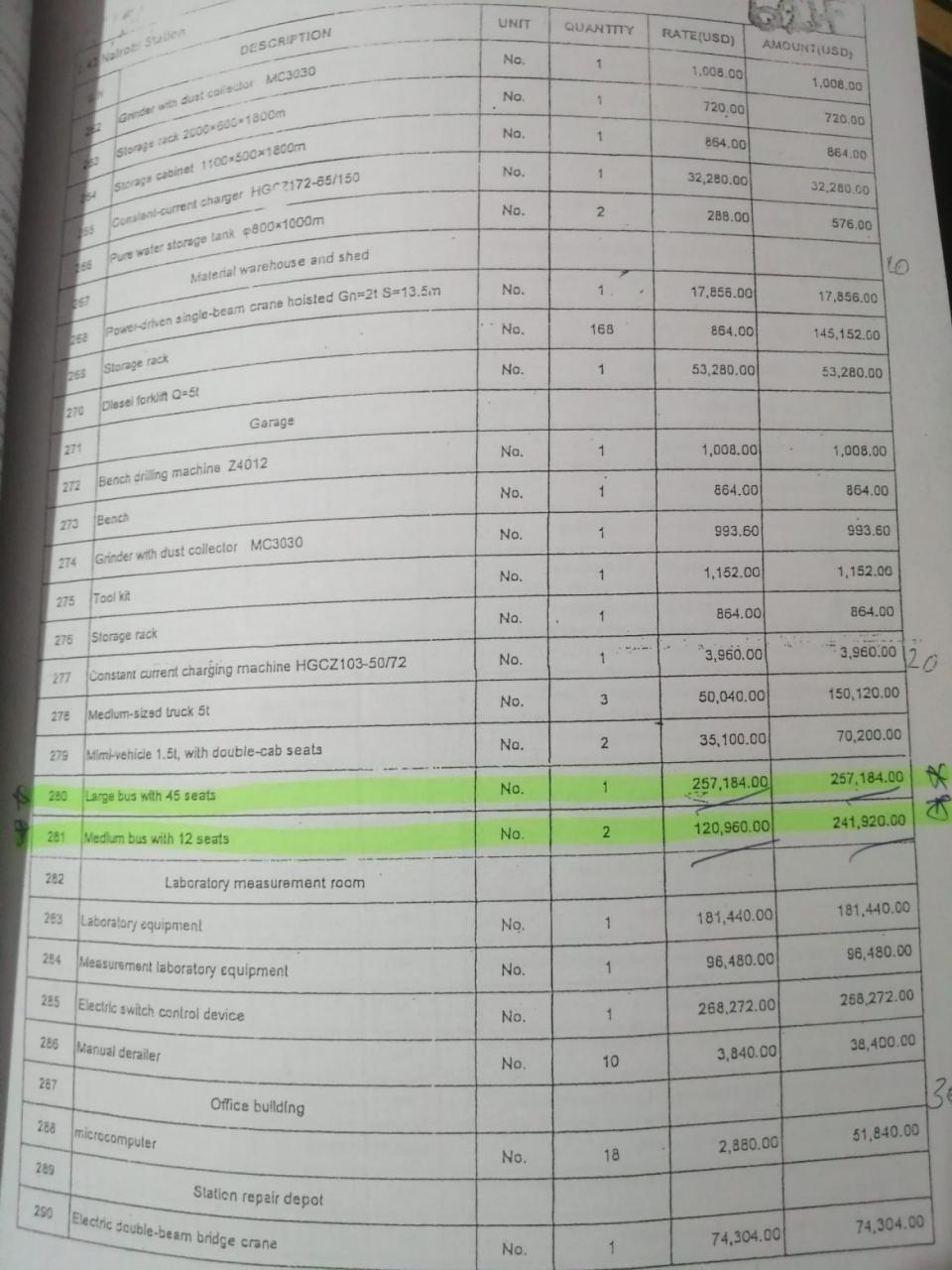
Further revelations from what has already been reported
The Nation Media Group reported: Digital voice recorders cost as little as Sh2,000 in Nairobi. These small costs here and there multiplied by the number of the gadgets being bought added up to billions of shillings.
CRBC also billed Kenyans Sh38 million to install a passenger guiding system, Sh14.6 million for each security system at the railway stations, Sh26 million for each luggage inspection system and Sh14 million for passenger monitoring systems at the stations.
The company also said it bought 46 A3 laser printers at Sh513,700 each for use at the stations during construction. The Nairobi station received five of these printers. These printers currently cost between Sh40,000 and Sh75,000.
Each of the intermediary stations also got a 30KW generator for use in case of power outage; Mombasa and Nairobi got two. The diesel generators, according to the contracts, were acquired at Sh4.26 million each. When the Nation asked around, we were told we could have one for Sh1.5 million.
Additionally, Kenyans paid Sh5.4 million for each of the 31 boreholes dug by CRBC in the intermediate stations. The Sh5.4 million is for drilling alone minus equipping and commissioning. The entire SGR from Mombasa to Nairobi has seven stations, which means each one was supposed to have three boreholes, a geological impossibility.
CRBC also said it needed to import six ZX7 DC/AC arc-welding machines as each station needed six of these for construction. These, according to CRBC, were bought at Sh442,872 each. We were able to get the same for Sh25,000 from Chinese manufacturers.
Moving on
The Standard Gauge Railways – SGR was initially planned to run from the port of Mombasa in Kenya, through to Kisumu and into Uganda via the Malaba border.
Phase one of the SGR gobbled Sh327 billion o the loan before factoring in loan fees and land acquisition costs.
Phase 2 of SGR: Nairobi to Naivasha got a loan of Ksh150 billion
Phase 2B of SGR: Naivasha to Kisumu was expected to cost Sh368 billion and was subject to loan negotiations a year ago (April 2019).
The final stretch was supposed to be Kisumu to Malaba border.
Cumulatively, from Mombasa to Kisumu, the SGR line was to cost SH845 billion or more. Mostly, pegged on overpriced equipment, engineers living kingly, govt officials pocketing kickbacks.
Kenyans must not forget that the railway that was built in phases, overpriced and unnecessary, made Sh10 billion loss in 2019 despite costing taxpayers Ksh12 billion to run.
It costs Sh1 billion a month to run the line between Mombasa and Nairobi. Kenya is struggling to manage it let alone paying the debt.
The serialization of the SGR contract continues next with part 2 showing more plunder and loot that has never been published before. (did Kenya pay China using other unofficial ways such as wildlife, elephant tusks, Rhino horns etc?)
Wait for part two.
